英语修辞概要
- 格式:doc
- 大小:77.00 KB
- 文档页数:7
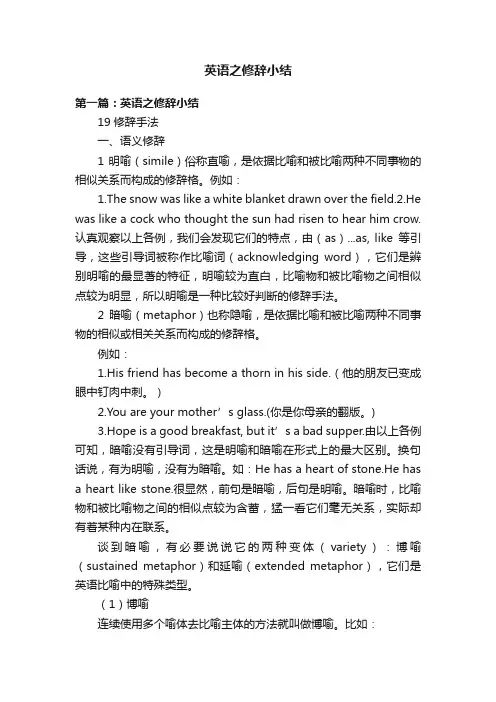
英语之修辞小结第一篇:英语之修辞小结19修辞手法一、语义修辞1明喻(simile)俗称直喻,是依据比喻和被比喻两种不同事物的相似关系而构成的修辞格。
例如:1.The snow was like a white blanket drawn over the field.2.He was like a cock who thought the sun had risen to hear him crow.认真观察以上各例,我们会发现它们的特点,由(as)...as, like等引导,这些引导词被称作比喻词(acknowledging word),它们是辨别明喻的最显著的特征,明喻较为直白,比喻物和被比喻物之间相似点较为明显,所以明喻是一种比较好判断的修辞手法。
2暗喻(metaphor)也称隐喻,是依据比喻和被比喻两种不同事物的相似或相关关系而构成的修辞格。
例如:1.His friend has become a thorn in his side.(他的朋友已变成眼中钉肉中刺。
)2.You are your mother’s glass.(你是你母亲的翻版。
)3.Hope is a good breakfast, but it’s a bad supper.由以上各例可知,暗喻没有引导词,这是明喻和暗喻在形式上的最大区别。
换句话说,有为明喻,没有为暗喻。
如:He has a heart of stone.He has a heart like stone.很显然,前句是暗喻,后句是明喻。
暗喻时,比喻物和被比喻物之间的相似点较为含蓄,猛一看它们毫无关系,实际却有着某种内在联系。
谈到暗喻,有必要说说它的两种变体(variety):博喻(sustained metaphor)和延喻(extended metaphor),它们是英语比喻中的特殊类型。
(1)博喻连续使用多个喻体去比喻主体的方法就叫做博喻。
比如:There again came out the second flash, with the spring of a serpent and the shout of a fiend, looked green as an emerald, and the reverberation was stunning.(爆发了第二次闪电,她像蛇一样蜿蜒,如魔鬼般嘶叫,像翠玉般碧绿,轰隆隆震耳欲聋。
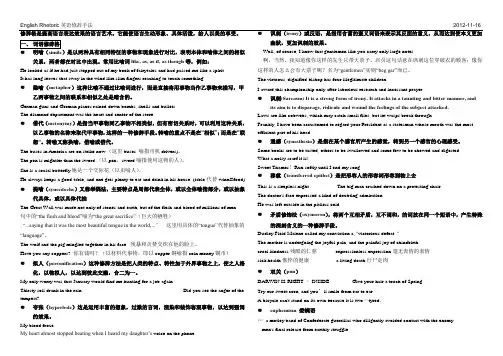
修辞格是提高语言表达效果的语言艺术。
它能使语言生动形象、具体活泼,给人以美的享受。
)是以两种具有相同特征的事物和现象进行对比,表明本体和喻体之间的相似关系,两者都在对比中出现。
常用比喻词like, as, as if, as though等,例如:He looked as if he had just stepped out of my book of fairytales and had passed me like a spirit.It has long leaves that sway in the wind like slim fingers reaching to touch something.隐喻(metaphor)这种比喻不通过比喻词进行,而是直接将用事物当作乙事物来描写,甲乙两事物之间的联系和相似之处是暗含的。
German guns and German planes rained down bombs, shells and bullets...The diamond department was the heart and center of the store.借代(metonymy)是指当甲事物同乙事物不相类似,但有密切关系时,可以利用这种关系,以乙事物的名称来取代甲事物,这样的一种修辞手段。
转喻的重点不是在“相似”;而是在“联想”。
转喻又称换喻,借喻或借代。
The buses in America are on strike now.(这里buses 喻指司机drivers)。
The pen is mightier than the sword.(以pen,sword喻指使用这物的人)。
She is a social butterfly.她是一个交际花(以虫喻人)。
He always keeps a good table, and one gets plenty to eat and drink in his house. (table代替wine&food) 提喻(synecdoche)又称举隅法,主要特点是局部代表全体,或以全体喻指部分,或以抽象代具体,或以具体代抽The Great Wall was made not only of stones and earth, but of the flesh and blood of millions of men.句中的“the flesh and blood”喻为“the great sacrifice”(巨大的牺牲)“...saying that it was the most beautiful tongue in the world,...” 这里用具体的“tongue”代替抽象的“language”。
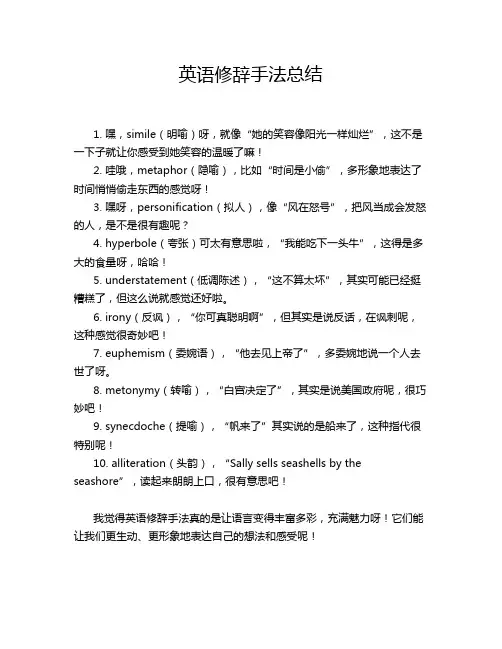
英语修辞手法总结
1. 嘿,simile(明喻)呀,就像“她的笑容像阳光一样灿烂”,这不是一下子就让你感受到她笑容的温暖了嘛!
2. 哇哦,metaphor(隐喻),比如“时间是小偷”,多形象地表达了时间悄悄偷走东西的感觉呀!
3. 嘿呀,personification(拟人),像“风在怒号”,把风当成会发怒的人,是不是很有趣呢?
4. hyperbole(夸张)可太有意思啦,“我能吃下一头牛”,这得是多大的食量呀,哈哈!
5. understatement(低调陈述),“这不算太坏”,其实可能已经挺糟糕了,但这么说就感觉还好啦。
6. irony(反讽),“你可真聪明啊”,但其实是说反话,在讽刺呢,这种感觉很奇妙吧!
7. euphemism(委婉语),“他去见上帝了”,多委婉地说一个人去世了呀。
8. metonymy(转喻),“白宫决定了”,其实是说美国政府呢,很巧妙吧!
9. synecdoche(提喻),“帆来了”其实说的是船来了,这种指代很特别呢!
10. alliteration(头韵),“Sally sells seashells by the seashore”,读起来朗朗上口,很有意思吧!
我觉得英语修辞手法真的是让语言变得丰富多彩,充满魅力呀!它们能让我们更生动、更形象地表达自己的想法和感受呢!。
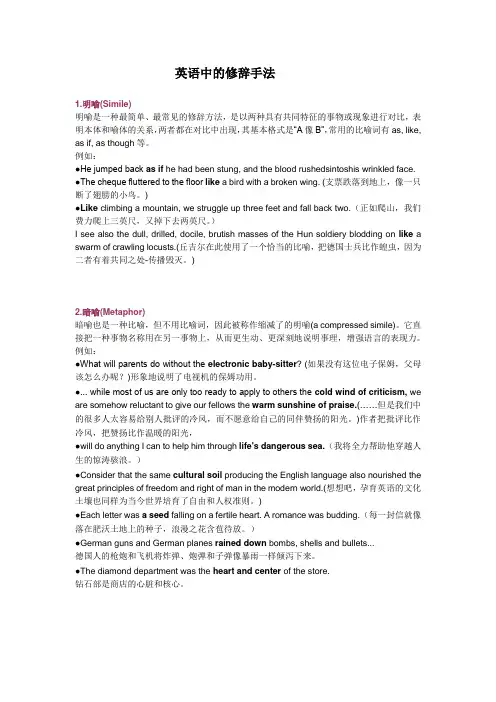
英语中的修辞手法1.明喻(Simile)明喻是一种最简单、最常见的修辞方法,是以两种具有共同特征的事物或现象进行对比,表明本体和喻体的关系,两者都在对比中出现,其基本格式是“A像B”,常用的比喻词有as, like, as if, as though等。
例如:●He jumped back as if he had been stung, and the blood rushedsintoshis wrinkled face.●The cheque fluttered to the floor like a bird with a broken wing. (支票跌落到地上,像一只断了翅膀的小鸟。
)●Like climbing a mountain, we struggle up three feet and fall back two.(正如爬山,我们费力爬上三英尺,又掉下去两英尺。
)I see also the dull, drilled, docile, brutish masses of the Hun soldiery blodding on like a swarm of crawling locusts.(丘吉尔在此使用了一个恰当的比喻,把德国士兵比作蝗虫,因为二者有着共同之处-传播毁灭。
)2.暗喻(Metaphor)暗喻也是一种比喻,但不用比喻词,因此被称作缩减了的明喻(a compressed simile)。
它直接把一种事物名称用在另一事物上,从而更生动、更深刻地说明事理,增强语言的表现力。
例如:●What will parents do without the electronic baby-sitter? (如果没有这位电子保姆,父母该怎么办呢?)形象地说明了电视机的保姆功用。
●... while most of us are only too ready to apply to others the cold wind of criticism, we are somehow reluctant to give our fellows the warm sunshine of praise.(……但是我们中的很多人太容易给别人批评的冷风,而不愿意给自己的同伴赞扬的阳光。
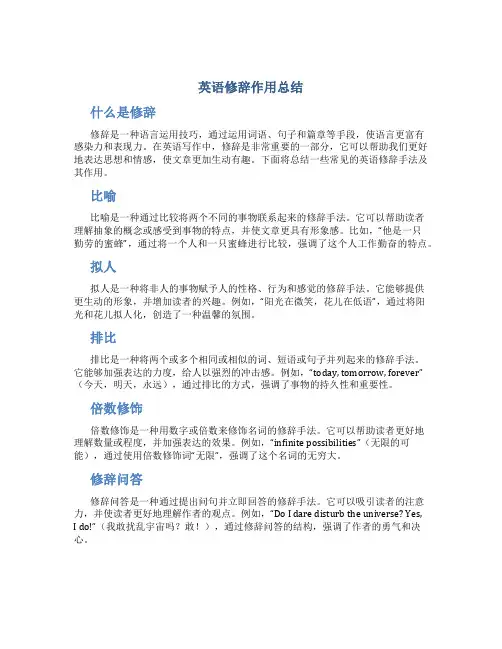
英语修辞作用总结什么是修辞修辞是一种语言运用技巧,通过运用词语、句子和篇章等手段,使语言更富有感染力和表现力。
在英语写作中,修辞是非常重要的一部分,它可以帮助我们更好地表达思想和情感,使文章更加生动有趣。
下面将总结一些常见的英语修辞手法及其作用。
比喻比喻是一种通过比较将两个不同的事物联系起来的修辞手法。
它可以帮助读者理解抽象的概念或感受到事物的特点,并使文章更具有形象感。
比如,“他是一只勤劳的蜜蜂”,通过将一个人和一只蜜蜂进行比较,强调了这个人工作勤奋的特点。
拟人拟人是一种将非人的事物赋予人的性格、行为和感觉的修辞手法。
它能够提供更生动的形象,并增加读者的兴趣。
例如,“阳光在微笑,花儿在低语”,通过将阳光和花儿拟人化,创造了一种温馨的氛围。
排比排比是一种将两个或多个相同或相似的词、短语或句子并列起来的修辞手法。
它能够加强表达的力度,给人以强烈的冲击感。
例如,“today, tomorrow, forever”(今天,明天,永远),通过排比的方式,强调了事物的持久性和重要性。
倍数修饰倍数修饰是一种用数字或倍数来修饰名词的修辞手法。
它可以帮助读者更好地理解数量或程度,并加强表达的效果。
例如,“infinite possibilities”(无限的可能),通过使用倍数修饰词“无限”,强调了这个名词的无穷大。
修辞问答修辞问答是一种通过提出问句并立即回答的修辞手法。
它可以吸引读者的注意力,并使读者更好地理解作者的观点。
例如,“Do I dare disturb the universe? Yes,I do!”(我敢扰乱宇宙吗?敢!),通过修辞问答的结构,强调了作者的勇气和决心。
转喻转喻是一种将一个概念与另一个概念进行类比的修辞手法。
它可以帮助读者更好地理解抽象的概念,并使文章更具有说服力。
例如,“Time is money”(时间就是金钱),通过将时间和金钱进行类比,强调了时间的珍贵和重要性。
反问反问是一种提出问题,但不期望回答的修辞手法。
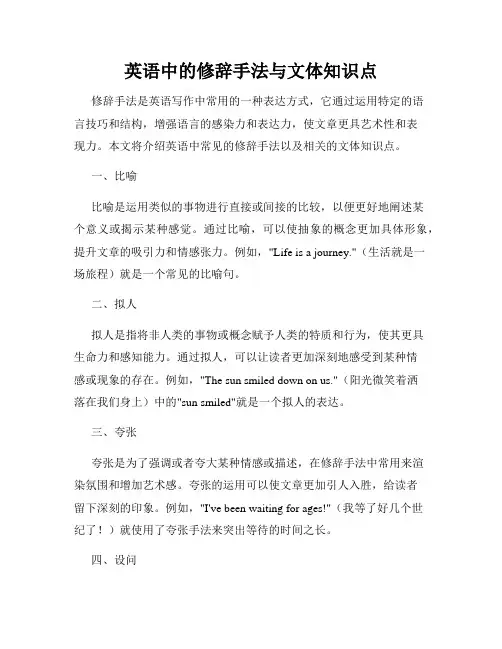
英语中的修辞手法与文体知识点修辞手法是英语写作中常用的一种表达方式,它通过运用特定的语言技巧和结构,增强语言的感染力和表达力,使文章更具艺术性和表现力。
本文将介绍英语中常见的修辞手法以及相关的文体知识点。
一、比喻比喻是运用类似的事物进行直接或间接的比较,以便更好地阐述某个意义或揭示某种感觉。
通过比喻,可以使抽象的概念更加具体形象,提升文章的吸引力和情感张力。
例如,"Life is a journey."(生活就是一场旅程)就是一个常见的比喻句。
二、拟人拟人是指将非人类的事物或概念赋予人类的特质和行为,使其更具生命力和感知能力。
通过拟人,可以让读者更加深刻地感受到某种情感或现象的存在。
例如,"The sun smiled down on us."(阳光微笑着洒落在我们身上)中的"sun smiled"就是一个拟人的表达。
三、夸张夸张是为了强调或者夸大某种情感或描述,在修辞手法中常用来渲染氛围和增加艺术感。
夸张的运用可以使文章更加引人入胜,给读者留下深刻的印象。
例如,"I've been waiting for ages!"(我等了好几个世纪了!)就使用了夸张手法来突出等待的时间之长。
四、设问设问是通过提出问题的方式引发读者的思考,增加文章的互动性和吸引力。
通过巧妙的设问,可以引导读者思考并产生共鸣,使文章更具说服力和启发性。
例如,"What would you do if you had one day left to live?"(如果你只剩下最后一天可以活,你会怎么做?)中的设问引发了读者对生活的思考。
五、对比对比是通过对两个事物进行比较,强调它们之间的不同之处或者相互关系,以达到突出或者对比的效果。
通过对比,可以使文章更加生动有趣,也更好地传达作者的观点。
例如,"His words were as sharp as a knife, while her words were as gentle as a breeze."(他的话锋锐如刀,而她的话则温柔如微风)中的对比句增加了文章的表现力和张力。
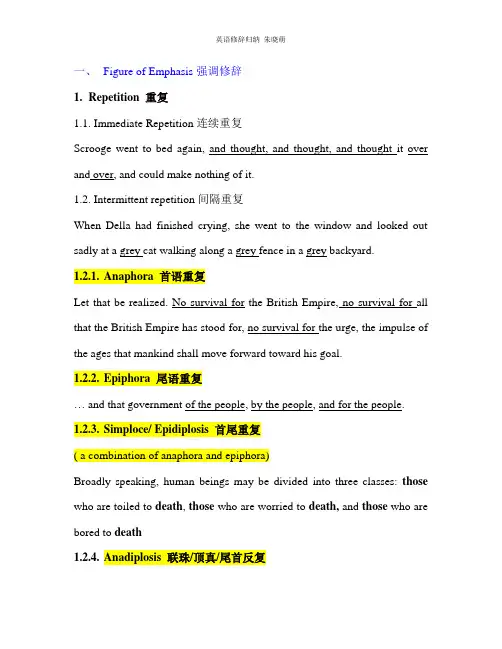
一、Figure of Emphasis强调修辞1.Repetition 重复1.1. Immediate Repetition连续重复Scrooge went to bed again, and thought, and thought, and thought it over and over, and could make nothing of it.1.2. Intermittent repetition间隔重复When Della had finished crying, she went to the window and looked out sadly at a grey cat walking along a grey fence in a grey backyard.1.2.1.Anaphora 首语重复Let that be realized. No survival for the British Empire, no survival for all that the British Empire has stood for, no survival for the urge, the impulse of the ages that mankind shall move forward toward his goal.1.2.2.Epiphora 尾语重复… and that government of the people, by the people, and for the people.1.2.3.Simploce/ Epidiplosis首尾重复( a combination of anaphora and epiphora)Broadly speaking, human beings may be divided into three classes: those who are toiled to death, those who are worried to death, and those who are bored to death1.2.4.Anadiplosis 联珠/顶真/尾首反复运用顶真修辞手法,不但能使句子结构整齐,语气贯通,而且能突出事物之间环环相扣的有机联系。
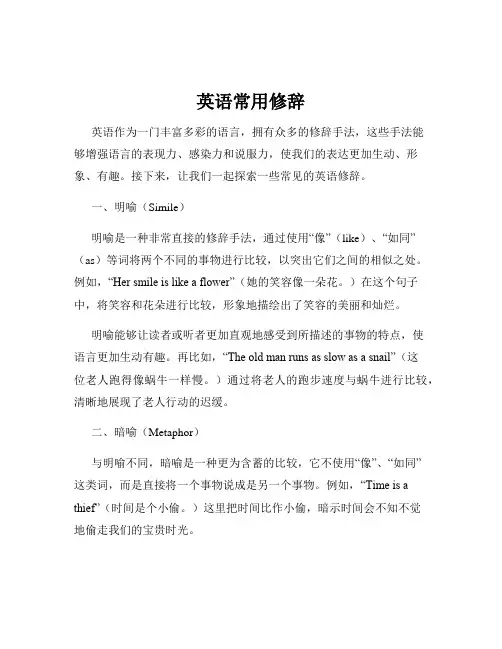
英语常用修辞英语作为一门丰富多彩的语言,拥有众多的修辞手法,这些手法能够增强语言的表现力、感染力和说服力,使我们的表达更加生动、形象、有趣。
接下来,让我们一起探索一些常见的英语修辞。
一、明喻(Simile)明喻是一种非常直接的修辞手法,通过使用“像”(like)、“如同”(as)等词将两个不同的事物进行比较,以突出它们之间的相似之处。
例如,“Her smile is like a flower”(她的笑容像一朵花。
)在这个句子中,将笑容和花朵进行比较,形象地描绘出了笑容的美丽和灿烂。
明喻能够让读者或听者更加直观地感受到所描述的事物的特点,使语言更加生动有趣。
再比如,“The old man runs as slow as a snail”(这位老人跑得像蜗牛一样慢。
)通过将老人的跑步速度与蜗牛进行比较,清晰地展现了老人行动的迟缓。
二、暗喻(Metaphor)与明喻不同,暗喻是一种更为含蓄的比较,它不使用“像”、“如同”这类词,而是直接将一个事物说成是另一个事物。
例如,“Time is a thief”(时间是个小偷。
)这里把时间比作小偷,暗示时间会不知不觉地偷走我们的宝贵时光。
暗喻能够使语言更加简洁有力,给人留下深刻的印象。
又如,“The classroom is a zoo”(教室是个动物园。
)形象地表达出教室里的喧闹和混乱。
三、拟人(Personification)拟人是赋予非人类的事物以人类的特征、行为或情感。
比如,“The wind whispered through the trees”(风在树林中低语。
)风本是没有生命的自然现象,但通过“低语”这个人类的动作,使其具有了人的特质,让读者更能感受到风的轻柔。
“The stars danced playfully in the sky”(星星在天空中欢快地跳舞。
)将星星的闪烁描绘成跳舞,充满了活泼和欢乐的氛围。
拟人手法可以让我们对周围的世界产生更加亲切和生动的感受。
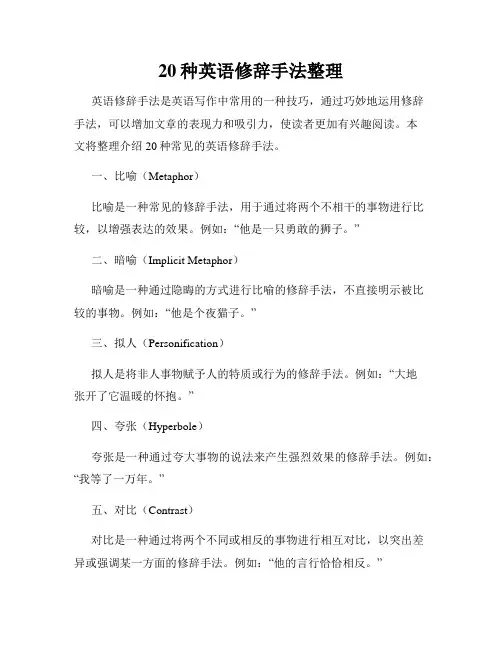
20种英语修辞手法整理英语修辞手法是英语写作中常用的一种技巧,通过巧妙地运用修辞手法,可以增加文章的表现力和吸引力,使读者更加有兴趣阅读。
本文将整理介绍20种常见的英语修辞手法。
一、比喻(Metaphor)比喻是一种常见的修辞手法,用于通过将两个不相干的事物进行比较,以增强表达的效果。
例如:“他是一只勇敢的狮子。
”二、暗喻(Implicit Metaphor)暗喻是一种通过隐晦的方式进行比喻的修辞手法,不直接明示被比较的事物。
例如:“他是个夜猫子。
”三、拟人(Personification)拟人是将非人事物赋予人的特质或行为的修辞手法。
例如:“大地张开了它温暖的怀抱。
”四、夸张(Hyperbole)夸张是一种通过夸大事物的说法来产生强烈效果的修辞手法。
例如:“我等了一万年。
”五、对比(Contrast)对比是一种通过将两个不同或相反的事物进行相互对比,以突出差异或强调某一方面的修辞手法。
例如:“他的言行恰恰相反。
”六、排比(Parallelism)排比是一种通过对句子或短语进行平行结构的修辞手法,以强调重点或增加语句的节奏感。
例如:“奋斗,拼搏,追求,努力。
”七、倒装(Inversion)倒装是一种颠倒语序的修辞手法,常常用于疑问句或为了强调某一部分。
例如:“Never have I seen such a beautiful sunset.”八、反问(Rhetorical Question)反问是一种用疑问句的形式表达肯定或否定的修辞手法,常用于强调某一观点或引起读者思考。
例如:“难道你不想成功吗?”九、比较(Comparison)比较是通过将两个事物进行对比,以凸显共同点或差异的修辞手法。
例如:“学习就像是爬山,充满了艰辛和挑战。
”十、设问(Hypophora)设问是一种在文章中提出问题,并在下文中进行回答的修辞手法,常用于引起读者的关注和思考。
例如:“你知道成功的秘诀是什么吗?答案很简单——努力。
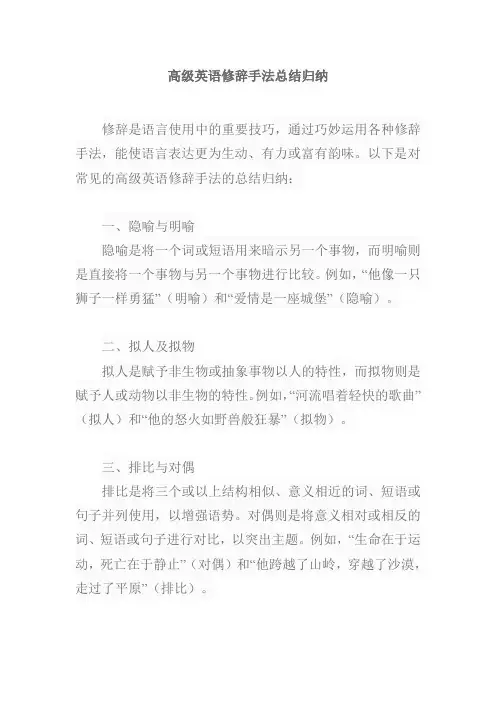
高级英语修辞手法总结归纳修辞是语言使用中的重要技巧,通过巧妙运用各种修辞手法,能使语言表达更为生动、有力或富有韵味。
以下是对常见的高级英语修辞手法的总结归纳:一、隐喻与明喻隐喻是将一个词或短语用来暗示另一个事物,而明喻则是直接将一个事物与另一个事物进行比较。
例如,“他像一只狮子一样勇猛”(明喻)和“爱情是一座城堡”(隐喻)。
二、拟人及拟物拟人是赋予非生物或抽象事物以人的特性,而拟物则是赋予人或动物以非生物的特性。
例如,“河流唱着轻快的歌曲”(拟人)和“他的怒火如野兽般狂暴”(拟物)。
三、排比与对偶排比是将三个或以上结构相似、意义相近的词、短语或句子并列使用,以增强语势。
对偶则是将意义相对或相反的词、短语或句子进行对比,以突出主题。
例如,“生命在于运动,死亡在于静止”(对偶)和“他跨越了山岭,穿越了沙漠,走过了平原”(排比)。
四、反复与交错反复是将相同的词、短语或句子重复使用,以强调某种情感或主题。
交错则是将不同的词、短语或句子相互交替使用,以达到特定的表达效果。
例如,“永远、永远、永远不要放弃”(反复)和“是与否,对与错”(交错)。
五、借代与提喻借代是用一个事物的某一部分来代替整体或其他部分,而提喻则是用整体来代替某一部分或用类属来代替个体。
例如,“我要用笔墨写下永恒”(借代)和“人是一本书”(提喻)。
六、反讽与戏谑反讽是通过说反话或正话反说来达到讽刺的效果,戏谑则是用幽默诙谐的语言来戏弄或嘲笑某人或某事。
例如,“他是一个天生的傻瓜”(反讽)和“爱情是人生的蜜糖”(戏谑)。
七、矛盾修辞法矛盾修辞法是将相互矛盾的概念或形象结合在一起,以引起读者的思考或表达复杂的情感。
例如,“孤独的狂欢”,“死亡的生命”。
八、头韵与脚韵头韵是使用相同或相似的音韵开头,脚韵是使用相同或相似的音韵结尾。
例如,“美丽的美女”(头韵)和“生活是一首歌”(脚韵)。
九、夸张与弱化夸张是通过夸大事实或形象来强调某种情感或主题,弱化则是通过缩小事实或形象来淡化某种情感或主题。
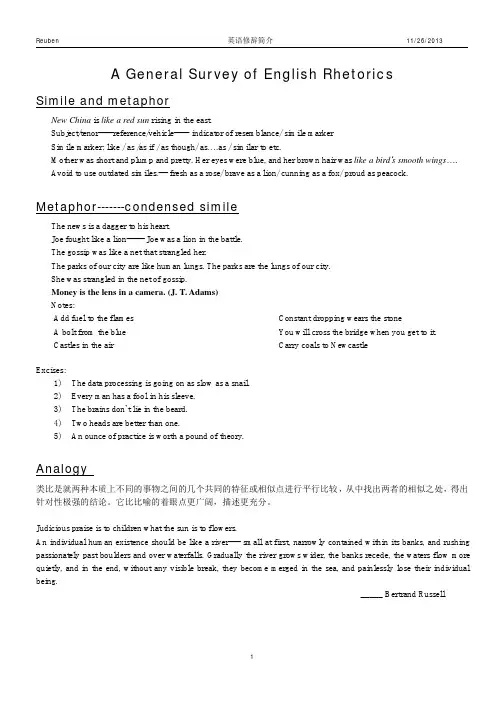
A General Survey of English RhetoricsSimile and metaphorNew China is like a red sun rising in the east.Subject/tenor-----reference/vehicle-----indicator of resemblance/simile markerSimile marker:like/as/as if/as though/as….as/similar to etc.Mother was short and plump and pretty.Her eyes were blue,and her brown hair was like a bird’s smooth wings….Avoid to use outdated similes.---fresh as a rose/brave as a lion/cunning as a fox/proud as peacock.Metaphor-------condensed simileThe news is a dagger to his heart.Joe fought like a lion------Joe was a lion in the battle.The gossip was like a net that strangled her.The parks of our city are like human lungs.The parks are the lungs of our city.She was strangled in the net of gossip.Money is the lens in a camera.(J.T.Adams)Notes:Add fuel to the flames A bolt from the blue Castles in the air Constant dropping wears the stoneYou will cross the bridge when you get to it. Carry coals to NewcastleExcises:1)The data processing is going on as slow as a snail.2)Every man has a fool in his sleeve.3)The brains don’t lie in the beard.4)Two heads are better than one.5)An ounce of practice is worth a pound of theory.Analogy类比是就两种本质上不同的事物之间的几个共同的特征或相似点进行平行比较,从中找出两者的相似之处,得出针对性极强的结论。
英文中的修辞手法英文中有许多修辞手法,这些手法通过运用特定的语言技巧,可以增强文学作品的表达力和感染力。
以下是一些常见的英文修辞手法:比喻(Metaphor):将两个不同的事物进行比较,以强调它们之间的相似之处,而不使用"like"或"as"。
例如:“时间是一把无情的剑。
”拟人(Personification):赋予非人物以人的特质或行为,使其更具生动性。
例如:“风儿轻轻地低语。
”象征(Symbolism):使用一个事物、符号或象征来代表另一个抽象概念。
例如:“燕子在文学中通常象征着春天和希望。
”暗喻(Metonymy):用一个与所指实体有着密切关联的词汇来替代它。
例如:“白宫发布了一份声明”中的“白宫”代表美国政府。
排比(Parallelism):通过使用相似的句式或结构,强调语言的平衡和韵律。
例如:“我不怕困难,我不怕失败,我不怕挑战。
”双关语(Pun):利用一个词汇项的多义性或相似的发音来制造幽默或引起思考。
例如:“时间飞逝,果然很‘秒’。
”讽刺(Irony):通过言辞上的反讽,表达与字面意义相反的意思。
例如:“这个‘伟大’的计划居然失败了。
”悬念(Suspense):通过保持某种信息的不明确,刺激读者的兴趣,以激发紧张感。
例如:“她打开门,里面的一切都让她惊呆了。
”对仗(Antithesis):将相对或对立的思想或概念通过并列的结构进行强调。
例如:“昨夜寒风凛冽,今朝暖阳明媚。
”比较(Simile):将两个事物通过使用"like"或"as"进行比较,以突显它们之间的相似之处。
例如:“她如同一朵盛开的花。
”这些修辞手法可以单独使用,也可以结合在一起,创造出更为复杂和富有表现力的文学效果。
作家通常根据他们的写作目的,选择最适合表达自己意图的修辞手法。
英语修辞手法总结Figures of speech (修辞)are ways of making our language figurative. When we use words in other than their ordinary or literal sense to lend force to an idea, to heighten effect, or to create suggestive imagery, we are said to be speaking or writing figuratively. Now we are going to talk about some common forms of figures of speech.1) Simile:(明喻)It is a figure of speech which makes a comparison between two unlike elements having at least one quality or characteristic (特性)in common. To make the comparison, words like as, as...as, as if and like are used to transfer the quality we associate with one to the other. For example, As cold waters to a thirsty soul, so is good news from a far country.2) Metaphor:(暗喻)It is like a simile, also makes a comparison between two unlike elements, but unlike a simile, this comparison is implied rather than stated. For example, the world is a stage.3) Analogy: (类比)It is also a form of comparison, but unlike simile or metaphor which usually uses comparison on one point of resemblance, analogy draws a parallel between two unlike things that have several common qualities or points of resemblance.4) Personification: (拟人)It gives human form of feelings to animals, or life and personal attributes(赋予) to inanimate(无生命的) objects, or to ideas and abstractions(抽象). For example, the wind whistled through the trees.5) Hyperbole: (夸张): It is the deliberate use of overstatement or exaggeration to achieve emphasis. For instance, he almost died laughing.6) Understatement: (含蓄陈述)It is the opposite of hyperbole, or overstatement. It achieves its effect of emphasizing a fact by deliberately(故意地) understating it, impressing the listener or the reader more by what is merely implied or left unsaid than by bare statement. For instance, It is no laughing matter.7) Euphemism: (委婉)It is the substitution of an agreeable or inoffensive(无冒犯) expression for one that may offend or suggest something unpleasant. For instance, we refer to "die" as” pass away".8) Metonymy (转喻)It is a figure of speech that has to do with the substitution of the mane of one thing for that of another. For instance, the pen (words) is mightier than the sword (forces).9) Synecdoche (提喻)It is involves the substitution of the part for the whole, or the whole for the part. For instance, they say there's bread and work for all. She was dressed in silks.10) Antonomasia (换喻)It has also to do with substitution. It is not often mentioned now, though it is still in frequent use. For example, Solomon for a wise man. Daniel for a wise and fair judge. Judas for a traitor.11) Pun: (双关语)It is a play on words, or rather a play on the form and meaning of words. For instance, a cannon-ball took off his legs, so he laid down his arms. (Here "arms" has two meanings: a person's body; weapons carried by a soldier.)12) Solipsism: (一语双叙)It has two connotations. In the first case, it is a figure by which a word, or a particular form or inflection of a word, refers to two or more words in the same sentence, while properly applying to or agreeing with only on of them in grammar or syntax(句法). For example, He addressed you and me, and desired us to follow him. (Here we are used to refer to you and me.)In the second case, it a word may refer to two or more words in the same sentence. For example, while he was fighting, and losing limb and mind, and dying, others stayed behind to pursue education and career. (Here to losing one's limbs in literal; to lose one's mind is figurative, and means to go mad.)13) Zeugma: (轭式搭配)It is a single word which is made to modify or to govern two or more words in the same sentence, wither properly applying in sense to only one of them, or applying to them in different senses. For example, the sun shall not burn you by day or the moon by night. (Here noon is not strong enough to burn)14) Irony: (反语)It is a figure of speech that achieves emphasis by saying the opposite of what is meant, the intended meaning of the words being the opposite of their usual sense. For instance, we are lucky, what you said makes me feel real good. 15) Innuendo: (暗讽)It is a mild form of irony, hinting in a rather roundabout (曲折)way at something disparaging(不一致) or uncomplimentary(不赞美) to the person or subject mentioned. For example, the weatherman said it would be worm. He must take his readings in a bathroom.16) Sarcasm: (讽刺)It Sarcasm is a strong form of irony. It attacks in a taunting and bitter manner, and its aim is to disparage, ridicule and wound the feelings of the subject attacked. For example, laws are like cobwebs, which may catch small flies, but let wasps break through.17) Paradox: (似非而是的隽语)It is a figure of speech consisting of a statement or proposition which on the face of it seems self-contradictory, absurd or contrary toestablished fact or practice, but which onfurther thinking and study may prove to be true, well-founded, and even to contain a succinct point. For example more haste, less speed.18) Oxymoron: (矛盾修饰)It is a compressed paradox, formed by the conjoining(结合) of two contrasting, contradictory or incongruous(不协调) terms as in bitter-sweet memories, orderly chaos(混乱) and proud humility(侮辱).19) Antithesis: (对照)It is the deliberate arrangement of contrasting words or ideas in balanced structural forms to achieve emphasis. For example, speech is silver; silence is golden.20) Epigram: (警句)It states a simple truth pithily(有利地) and pungently(强烈地). It is usually terse and arouses interest and surprise by its deep insight into certain aspects of human behavior or feeling. For instance, Few, save the poor, feel for the poor.21) Climax: (渐进)It is derived from the Greek word for "ladder" and implies the progression of thought at a uniform or almost uniform rate of significance or intensity, like the steps of a ladder ascending evenly. For example, I came, I saw, I conquered.22) Anti-climax or bathos: (突降) It is the opposite of Climax. It involves stating one's thoughts in a descending order of significance or intensity, from strong to weak, from weighty to light or frivolous. For instance, But thousands die, without or this or that, die, and endow(赋予) a college, or a cat.23) Apostrophe:(顿呼)In this figure of speech, a thing, place, idea or person (dead or absent) is addressed as if present, listening and understanding what is being said.For instance, England! awake! awake! awake!24) Transferred Epithet: (转类形容词)It is a figure of speech where an epithet (an adjective or descriptive phrase) is transferred from the noun it should rightly modify(修饰) to another to which it does not really apply or belong. For instance, I spent sleepless nights on my project.25) Alliteration: (头韵)It has to do with the sound rather than the sense of words for effect. It is a device that repeats the same sound at frequent intervals(间隔) and since the sound repeated is usually the initial consonant sound, it is also called "front rhyme". For instance, the fair breeze blew, the white foam flew, the furrow followed free.26) Onomatopoeia: (拟声)It is a device that uses words which imitate the sounds made by an object (animate or inanimate), or which are associated with or suggestive(提示的) of some action or movement。
英语修辞的分类英语修辞是指在语言表达中使用一些特定的技巧和手法,以达到更加生动、有力、富于感染力的效果。
英语修辞可以分为多种类型,下面将对常见的几种类型进行详细介绍。
一、比喻比喻是指用一个事物来比拟另一个事物,以便更好地表达出其特点。
比如,“他是一只狮子”、“她的笑容像春天的阳光”,这些都是比喻的例子。
比喻可以让人们更加形象地理解事物,同时也能够增加语言表达的感染力。
二、拟人拟人是指将无生命的事物或抽象的概念赋予人的特征和行为。
比如,“风儿轻轻地拂过我的脸庞”、“时间在无声中流逝”,这些都是拟人的例子。
通过拟人,可以让人们更好地感受到事物的特点和气质,同时也能够增强语言表达的生动性。
三、夸张夸张是指在表达中对某个事物或情况进行过分强调,以达到更加生动、夸张、有力的效果。
比如,“他跑得飞快,像一只闪电”、“这个问题已经困扰我一百年了”,这些都是夸张的例子。
夸张可以让语言表达更加生动有趣,同时也能够增强表达者的感染力。
四、排比排比是指在表达中使用相同或相似的语法结构,以达到强调和鲜明对比的效果。
比如,“我想要的不是金钱,不是权力,不是名利,而是自由”、“他们来自不同的国家,不同的文化,不同的背景,但他们有一个共同点——热爱音乐”,这些都是排比的例子。
排比可以让语言表达更加优美、有力,同时也能够增强表达者的说服力。
五、反问反问是指在表达中使用疑问句来表达肯定或否定的意思,以达到强调和反驳的效果。
比如,“难道你不知道这个道理吗?”、“难道你不想变得更优秀吗?”这些都是反问的例子。
反问可以让语言表达更加生动、有力,同时也能够增强表达者的说服力。
六、修辞问答修辞问答是指在表达中使用一种特殊的问答方式,以达到强调和反复强调某个观点或结论的效果。
比如,“你认为什么才是最重要的?——爱!你认为什么才是最美好的?——爱!”这就是修辞问答。
修辞问答可以让语言表达更加生动、有力,同时也能够增强表达者的说服力。
七、借代借代是指用一个词代替另一个词,以便更好地表达出其特点。
英语修辞手法英语定义修辞手法是英语写作中经常使用的一种技巧,通过运用一定的语法和词汇结构,以达到增强文章表达力、形象生动、感染读者等效果的目的。
本文将介绍英语修辞手法的定义以及常见的几种修辞手法。
一、英语修辞手法的定义英语修辞手法指的是通过特定的词语、句式或修辞手段来增加语言的表现力,使文章更具吸引力和感染力。
它们能够帮助作者传达更准确、更具有感染力的信息,同时也能够使读者更容易理解和接受这些信息。
英语修辞手法涉及词法、语法和修辞三个方面,常常用于文学作品、演讲和广告等多种语境中。
二、常见的英语修辞手法1. 比喻(Metaphor)比喻是将一个物体或概念与另一个不相关的物体或概念进行类比,以突出某种特性或表达某种意义。
比如:“他是个太阳,照亮了我生活的每个角落。
”其中“太阳”是比喻,用来形容他的光芒和温暖。
2. 拟人(Personification)拟人是将非人类的事物赋予人的特点和行为,使其更生动有趣。
例如:“时间像一只无形的鸟,轻轻地飞过。
”其中时间被拟人化为一只飞鸟。
3. 反问(Rhetorical Question)反问是提出一个问题,但并不期望得到回答,而是用来强调观点或引起读者的思考。
例如:“你难道不希望自己过上幸福快乐的生活吗?”这个反问句用来表达作者的期待和呼吁。
4. 排比(Parallelism)排比是将多个相同或相似的句式结构或词语进行并列排列,以增加语言的节奏感和修辞效果。
比如:“春风送暖,夏日炎炎,秋叶飘落,冬雪皑皑。
”这个句子中的排比使用了相似的句式和词语,使得句子更流畅、有韵律感。
5. 夸张(Hyperbole)夸张是为了强调某个事物或情感,故意夸大其表达,以产生强烈的效果。
例如:“我饿得可以吞下一头大象!”这句话用夸张的方式表达了饥饿的感受。
6. 反复(Repetition)反复是指有意词语或句子的重复出现,以加强表达力和引起读者的共鸣。
例如:“Never give up, never give in.”这种反复使用相同词语的表达方式,可以使观点更加坚定和有力。
英语修辞手法英语中的修辞与汉语的修辞相比,分类细,种类多.下面将英语的修辞简单介绍如下:1.Simile 明喻明喻是将具有共性的不同事物作对比.这种共性存在于人们的心里,而不是事物的自然属性.标志词常用like, as, seem, as if, as though, similar to, such as等.例如:1>.He was like a cock who thought the sun had risen to hear him crow.2>.I wandered lonely as a cloud.3>.Einstein only had a blanket on, as if he had just walked out of a fairy tale.2.Metaphor 隐喻,暗喻隐喻是简缩了的明喻,是将某一事物的名称用于另一事物,通过比较形成.例如:1>.Hope is a good breakfast, but it is a bad supper.2>.Some books are to be tasted, others swallowed, and some few to be chewed and digested.3.Metonymy 借喻,转喻借喻不直接说出所要说的事物,而使用另一个与之相关的事物名称.I.以容器代替内容,例如:1>.The kettle boils. 水开了.2>.The room sat silent. 全屋人安静地坐着.II.以资料.工具代替事物的名称,例如:Lend me your ears, please. 请听我说.III.以作者代替作品,例如:a complete Shakespeare莎士比亚全集VI.以具体事物代替抽象概念,例如:I had the muscle, and they made money out of it. 我有力气,他们就用我的力气赚钱.4.Synecdoche 提喻提喻用部分代替全体,或用全体代替部分,或特殊代替一般.例如:1>.There are about 100 hands working in his factory.(部分代整体)他的厂里约有100名工人.2>.He is the Newton of this century.(特殊代一般)他是本世纪的牛顿.3>.The fox goes very well with your cap.(整体代部分)这狐皮围脖与你的帽子很相配.5.Synaesthesia 通感,联觉,移觉这种修辞法是以视.听.触.嗅.味等感觉直接描写事物.通感就是把不同感官的感觉沟通起来,借联想引起感觉转移,“以感觉写感觉”。
英语修辞手法小结Stella整理明喻(Simile);暗喻/隐喻(metaphor);提喻(synecdoche);转喻/借代(metonymy);拟人(personification);夸张(hyperbole);反语/讽刺(irony);双关(pun);叠言(rhetorical repetition);通感(synesthesia);拟声(onomatcpocia);头韵法(alliteration);交错法(chiasmus);委婉语(euphemism);对照(contrast);矛盾修辞法(oxymoron);移就(transferred epithet);异叙(syllepsis);粘连(zeugma);仿拟(parody);隽语(paradox);低调(understatement)2.结构修辞格(Syntactical Stylistic Devices)反复(repetition);联珠(catchword repetition);回文(chiasmus);平行结构(parallelism);反对(antithesis);设问(rhetoric question);突降(anticlimax)3.音韵修辞格(Phonetic Stylistic Devices)头韵(alliteration);拟声(onomatopoeia)Analogy类比Understatement含蓄陈述Syllepsis一语双叙Zeugma轭式搭配Innuendo暗讽Sarcasm讽刺Paradox似非而是的隽语Oxymoron矛盾修饰Antithesis对照Epigram警句Climax渐进Anti-climax or bathos突降Apostrophe顿呼Apostrophe顿呼Transferred Epithet转类形容词understatement低调contrast对照transferredepithet移就syllepsis异叙zeugma粘连repetition 反复catchword repetition联珠chiasmus回文parallelism平行结构rhetoric question设问1. 明喻(simile)是用like, as, as...as, as if(though) 或用其他词语指出两个不同事物的相似之处。
An Introduction to English Figures of Speech1. Simile (明喻)A simile is an expression making a comparison in the imagination between two things that are essentially unlike, yet are alike in a certain respect. A simile is made up of three parts, namely : a) the tenor ( the thing described) b) the vehicle ( the thing compared to) , and c) words such as “as”, “like”, “as if / as though”, “and” and the structure “ of+ noun.”used to show the relationship of comparison. For example:He is as stubborn as a mule.That man can‟t be trusted. He is as slippery as an eel.O my love‟s like a red, red rose. (woman—rose ) -----Robert BurnsThe past rises before me like a dream.Jim and Billy are as like as two peas.*He had no more idea of art than a cow.Who is to blame but her tyrant of a father?That is one hell of a jury.2. Metaphor(暗喻)A metaphor is the use of a phrase which describes one thing by stating another thing with which it can be compared without using the words “as” or “like”. It is also a comparison between two things that are essentially unlike yet are alike in a certain respect. It differs from simile in that there are no words whatsoever used to show the relation of comparison between the tenor and the vehicle. A genuine metaphor therefore, is an implied simile. For example:The world is a stage.Jim was a fox.He is the soul of the team.Failure is the mother of success.Some books are to be tasted, others swallowed, and some few to be chewed and digested.--------(Bacon) She melted into tears.He is a lion in the way.The man is the black sheep in the family.A dark horseI was able to rise from the ashes. (凤凰焚身的形象)(我终于从灰烬中获得新生/我终于得以东山再起)A mixed metaphor is one in which the writer starts with one comparison and then shifts to another that is not consistent with the first; the implications of one image clash with those of another.3. Personification(拟人)Personification is a figure of speech which attributes human qualities and abilities to inanimate objects, animals, abstract ideas, eg.Youth is hot and bold, (青春充满热情和勇气)Age is weak and cold, (衰老变得虚弱和冷漠)Youth is wild, and age is tame.(青春豪放不羁,衰老温顺驯服)----William ShakespeareThis time fate was smiling to him.The wind is whistling through the trees.Dusk came stealthily.(黄昏悄悄来临)I watched the moonlight dancing on the ripples of the lake.She listened to the brook murmuring through the hills.The ancient mansion spoke to me of bygone days.4. Metonymy (转喻)Metonymy is a figure of speech as consists in the use of the name of one thing for the name of another. It expresses an association between the thing spoken of and the thing meant-----the mention of one suggests the other. The most often used ones are as follows :e a container to represent the thing contained, e.g.The kettle is boiling.The hall applauded.e clear signs of an object to represent the object itself, e.g.Those big noses, blue eyes and yellow hairs taught them English. Grey hair should be respected. ( Big noses, blue eyes and yellow hair stand for foreigners. Grey hair stands for old people.)e tools to represent actions or the agentHis pen proves mightier than his pickax. (his pen—what is written by the pen; books and articles, etc.; pickax—mining (gold) or prospecting by pickax )d. Use organs to represent their functionsI was not one to let my heart rule my head. (heart—feelings or emotions; head(brain)—wisdom, intelligence, reason)He not only has an ear for music but also a ready tongue. ( ear for music—talent for music;ready tongue—eloquence )e the names of writers to represent their writingsI like to read Shakespeare .e an organ to represent its function.He writes a good hand. (His handwriting is legible (good).)e the thing related to represent the thing itself.He keeps a good table. ( He provides good food.)He took to the bottle. ( He took to drinking.)She took the veil at 20. (She became a nun at 20.)He enjoyed a good fame in the bar. ( legal profession)e quotation or proverb to represent characteristics of someone or something.You are all the salt of the earth. Our hope is placed on you. (社会中坚)Little Mary is the apple of her father‟s eye. (掌上明珠)Everybody has his Achilles‟ heel. (致命弱点)i. Use place names or locations to represent government , business or industrial enterprisesDowning Street : the British government or cabinetThe White House : the president or Executive branch of the U.S. governmentThe Pentagon: the U.S. military establishmentFleet Street: the British pressWall street: U.S. financial circlesMadison Avenue: American advertising industryHollywood: American film-making industry5. Synecdoche (提喻)Synecdoche means giving the part for the whole or vice versa, using a kind of thing to represent another big kind or vice versa, and using raw material to represent the thing made of it.e the part to represent the wholeTwenty years later when he came back to his home town, he saw many new faces.(strangers)The farms are short of hands during the harvest season.(workers)He has a fleet of fifty sails.(ships)Great minds think alike.(great persons)e the whole to represent the partThe score is 2 to 1 in favor of China. (Chinese team)The world stands by our side.e a kind of thing to represent another big kind.It is said that the cutthroat still remains at large.e a big kind of thing to represent another kind of thing.The poor creature could no longer endure her sufferings. (a woman)e raw material to represent the thing made of it.The family has been on the boards since the grandfather‟s time. (the stage)e concrete things to represent abstract things or vice versa.There is a mixture of the tiger and ape in the character of Frenchman. ( …tiger‟ and …ape‟ stands for the quality of …ferocity‟ and …cunningness‟ )All the wit and learning were assembled here. (the wit—the clever and wise people;learning—learned people)6. Antithesis (对句,对偶)Antithesis is a figure of speech which is a contrast of ideas expressed by parallelism of strongly contrasted words, generally for a tuneful rhythm and wisdom of brevity. For example, Crafty men condemn studies; simple men admire them; and wise men use them.Speech is silver, silence is golden.It was the best of times; it was the worst of times; it was the age of wisdom, it was the age of foolishness, it was the epoch of belief, it was the epoch of incredulity, it was the season of Light, it was the season of Darkness, it was the spring of Hope, it was the winter of Despair, we had everything before us, we had nothing before us, we were all going direct to Heaven, we were all going direct the other way. (Dickens ----- A tale of Two Cities)7. Climax (层进)Climax involves that part in a related set or list of events, ideas, expressions, etc. , which is most powerful, interesting, and effective, and which usually comes near the end. For example,I am sorry, I am very sorry, I am so extremely sorry.He threatened to swear at people, beat people and murder people.The audience smiled, chuckled, and finally howled. (微笑,窃窃而笑,捧腹大笑)We are low—we‟re low—we are very, very low, as low as low can be.(我们低贱—我们低贱—我们非常非常低贱,低贱得不能再低贱。